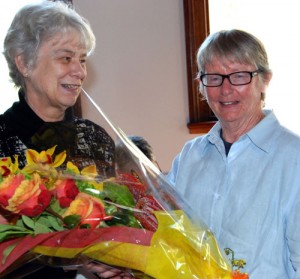
following her election as a Life Member.
Dr Lesley Lynch was elected a Life Member of the Glebe Society at the 2013 annual general meeting. Her citation is reproduced below.
Lesley’s relatively recent involvement with the Glebe Society takes place against a background of radical activism, both within and outside the Glebe community. As a young student at Sydney University, Lesley was part of the collective that formed Women’s Liberation at 67 Glebe Point Road, a building then owned by Bob Gould. Anne Curthoys spoke at a recent Glebe Voices event of the production of the first women’s liberation journal here, MeJane. More recently, following a professional career that included oversight of Glebe’s schools as Regional Director (members may recall the role of Special Education at Forest Lodge Primary) and two years improving education in Papua New Guinea, she took up the reins of the NSW Council for Civil Liberties, an organisation that had its head office in St Johns Road for many years. She settled in Glebe permanently in 1991.
Lesley became President in January, 2009, taking over from Jan Macindoe who assured her it would be a quiet year, and remained at that post until the end of 2010. 2009 was the fortieth anniversary of the founding of the Glebe Society, and this was marked by the publication of a short history of the Society, Celebrating Conservation and Change in Glebe, and also by a series of celebrations, a community party at the Woolcock Institute, a musical event at Margaretta Cottage, both in June, and an especially large Christmas Party at the restored Wentworth Park complex in December. 2009 was also the Sesquicentenary of Local Government in Glebe, and this was commemorated by a series of events organised by the Society throughout August and supported by the City of Sydney, including an exhibition of historic photos, an art exhibition, a time capsule and special hockey and rowing events. Australia’s first Prime Minister was commemorated by the naming of the Arundel Street Edmund Barton Footbridge in March, a result of a ten year campaign by Liz-Simpson Booker.
However, amid all the celebrations trouble was brewing. The new City Plan and the rezoning of Harold Park were proceeding fairly smoothly, but the Orphan School Creek Native Habitat Reserve erupted when the City inserted a zigzag disabled pathway that annoyed a lot of people, as there was already disabled access, and the path savaged the plan. The really big ones, though, were the development proposals for the Bays, and this was to consume Lesley’s life for several years.
Lesley wrote to the Premier expressing frustration and anger at the lack of integrated planning for the Bays, an issue that had been given special force by the piecemeal proposals such as the boat repair workshops, dry boat storage and various other controversial uses. Lurking in the background were related major proposals nearby, such as Barangaroo and the Cruise Ship Terminal. On 12 June Minister Keneally announced the Bays Precinct Planning and Consultation process. Lesley immediately threw her weight into the Community Reference Group to ensure proper consultation took place. At stake was 80 hectares of prime Harbour Foreshore land. Part of the Community Reference Group also produced the only comprehensive plan for the future of the Bays.
Lesley played a major role in uniting the very diverse communities around the Bays to produce a set of planning principles. Meetings were held with Councillors, senior state public servants and government and opposition politicians, culminating in a public meeting on 7 July, 2010, attended by 140 people. As a result of these efforts, the Government Bays Task Force, previously consisting entirely of Government departments, was extended to include representatives of the City and Leichhardt Councils plus one community representative, Prof. Jane Marceau, with Lesley as the alternate. While disappointing in some respects, the Task Force did endorse the principle of public ownership of the foreshores.
Lesley’s knowledge of policy development and strategic planning were also valuable in the negotiations over the planning agreement with Harold Park Paceway. The benefits that were secured include preservation and restoration of the historic Tramsheds, with 500 sq m of community space, 35% of the total site to be Public Open Space, and enough land for 50 units of Affordable Housing.










There are no comments yet. Please leave yours.